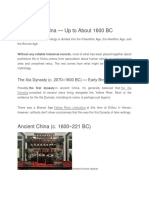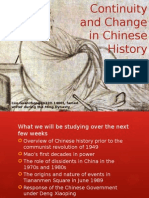0 ratings0% found this document useful (0 votes)
4 viewsThe History of China
The History of China
Uploaded by
ayyash lukmanCopyright:
© All Rights Reserved
Available Formats
Download as DOCX, PDF, TXT or read online from Scribd
The History of China
The History of China
Uploaded by
ayyash lukman0 ratings0% found this document useful (0 votes)
4 views2 pagesOriginal Title
THE HISTORY OF CHINA
Copyright
© © All Rights Reserved
Available Formats
DOCX, PDF, TXT or read online from Scribd
Share this document
Did you find this document useful?
Is this content inappropriate?
Copyright:
© All Rights Reserved
Available Formats
Download as DOCX, PDF, TXT or read online from Scribd
Download as docx, pdf, or txt
0 ratings0% found this document useful (0 votes)
4 views2 pagesThe History of China
The History of China
Uploaded by
ayyash lukmanCopyright:
© All Rights Reserved
Available Formats
Download as DOCX, PDF, TXT or read online from Scribd
Download as docx, pdf, or txt
You are on page 1of 2
THE HISTORY OF CHINA
China boasts one of the longest and richest histories of any civilization on Earth,
stretching back thousands of years. It's a story of dynasties rising and falling,
groundbreaking inventions, cultural flourishing, and periods of foreign influence.
Here's a glimpse into some of the key chapters of this fascinating narrative:
Early Civilizations (2100 BC - 221 BC): The earliest whispers of Chinese
history come from the Xia Dynasty (2100 - 1600 BC), though evidence for its
existence is scarce. The Shang Dynasty (1600 - 1046 BC) left behind concrete
proof in the form of intricate bronze works and a writing system. The Zhou
Dynasty (1046 - 256 BC) ushered in a feudal system and saw the rise of
Confucianism and Daoism, two philosophies that would profoundly shape
Chinese thought.
Imperial China (221 BC - 1912 AD): Qin Shi Huang, the first emperor of a
unified China, emerged in 221 BC. He standardized writing, weights, and
measurements, and even ordered the construction of the Great Wall. The Han
Dynasty (206 BCE – 220 CE) is considered a golden age. The Silk Road, a
network of trade routes, flourished, and inventions like paper and gunpowder
were made. Following the Han, China cycled through periods of fragmentation
and reunification under various dynasties, including the Tang Dynasty (618-907
AD), another high point known for its cultural and artistic achievements.
Challenges and Change (19th - early 20th centuries): The 19th century brought
increasing conflict with European powers. The Opium Wars (1839-1842, 1856-
1860) forced China to open trade concessions to Western nations, which chipped
away at its sovereignty. Internal rebellions and a weakening Qing Dynasty (1644-
1912) added to the turmoil.
Revolution and the Birth of Modern China (1911 - 1949): The Xinhai
Revolution of 1911, led by Sun Yat-sen, toppled the Qing Dynasty and
established the Republic of China. However, the first half of the 20th century was
a period of instability, marked by civil war between the Nationalists under Chiang
Kai-shek and the Communists led by Mao Zedong. The Japanese invasion of
China in World War II further complicated the situation.
The People's Republic of China (1949 - Present): The Communist Party
emerged victorious from the civil war in 1949. Mao Zedong declared the People's
Republic of China, and the Nationalists retreated to Taiwan. Mao's rule was
marked by radical social and economic reforms, including the Great Leap
Forward and the Cultural Revolution. After Mao's death in 1976, China embarked
on a period of economic reform and opening up to the world under Deng
Xiaoping. China has become a major economic and political power in the 21st
century, but its past continues to shape its present and future.
You might also like
- Joey Yap 7 Nov - 14 Nov 2024 QM Manifesting Planner1-14.2 MBDocument19 pagesJoey Yap 7 Nov - 14 Nov 2024 QM Manifesting Planner1-14.2 MBLay Tekchhay100% (1)
- Giai Thich Chi Tiet 5,6 Economy New Format PDFDocument145 pagesGiai Thich Chi Tiet 5,6 Economy New Format PDFNhật Nguyễn100% (14)
- Module 1: Philosophical Perspective of The SelfDocument10 pagesModule 1: Philosophical Perspective of The SelfJANMATTHEW PAPANo ratings yet
- The History of ChinaDocument2 pagesThe History of ChinaJohn Rex VillanuevaNo ratings yet
- The History of ChinaDocument22 pagesThe History of ChinaJulcess Marie MercadoNo ratings yet
- Ancient ChinaDocument2 pagesAncient Chinambc0349fbdNo ratings yet
- Music of ChinaDocument43 pagesMusic of ChinaJcee EsurenaNo ratings yet
- History of China.2Document2 pagesHistory of China.2Cherry Mae ElevazoNo ratings yet
- Chat GPT Gen TextDocument1 pageChat GPT Gen TextbhaaakavefwktwhpeqNo ratings yet
- History of ChinaDocument3 pagesHistory of ChinaHelmi EffendyNo ratings yet
- History of China.3Document2 pagesHistory of China.3Cherry Mae ElevazoNo ratings yet
- Prehistoric ChinaDocument12 pagesPrehistoric ChinaHyun Sairee VillenaNo ratings yet
- Rolan Niño D Albarico ICS33 WEEK #1Document3 pagesRolan Niño D Albarico ICS33 WEEK #1Rolan AlbaricoNo ratings yet
- He Dynasties and PeriodsDocument15 pagesHe Dynasties and PeriodswennyNo ratings yet
- Annotated Chronological Outline of Chinese HistoryDocument3 pagesAnnotated Chronological Outline of Chinese HistorySyazwani Suif100% (1)
- 中国王朝Document6 pages中国王朝Avery Haye LimNo ratings yet
- ChinaDocument33 pagesChinasumit kumar singhNo ratings yet
- History of ChinaDocument1 pageHistory of ChinaCherry Mae ElevazoNo ratings yet
- ChinaDocument3 pagesChinapepanovak74No ratings yet
- The History of The China EssayDocument3 pagesThe History of The China EssayMario SalinasNo ratings yet
- Sunu 1Document30 pagesSunu 1Muhammed Salih AKBULUTNo ratings yet
- Quarterly Company Review Professional Presentation in Sky Blue White Grey M - 20240505 - 081138 - 0000Document10 pagesQuarterly Company Review Professional Presentation in Sky Blue White Grey M - 20240505 - 081138 - 0000bachamandashreerakshaNo ratings yet
- The History of China A 5000 Year JourneyDocument9 pagesThe History of China A 5000 Year JourneyDumas JohnNo ratings yet
- ChinaDocument2 pagesChinaMarifer DineroNo ratings yet
- Chinese DynastiesDocument3 pagesChinese DynastiesEMPRON ALVIE JEAN I.No ratings yet
- Records of The Grand Historian Bamboo AnnalsDocument2 pagesRecords of The Grand Historian Bamboo Annalsaccountingtutor01No ratings yet
- China DynastiesDocument5 pagesChina DynastiesJennifer Anne DavidNo ratings yet
- Cup RinsDocument16 pagesCup RinsMaria MusteataNo ratings yet
- Class NotesHistory of China With Detalied Explanation Up Until Covid19Document44 pagesClass NotesHistory of China With Detalied Explanation Up Until Covid19gideonNo ratings yet
- China HistoryDocument1 pageChina Historyapi-374137353No ratings yet
- History of China - WikipediaDocument3 pagesHistory of China - WikipediaCharles Daniel RosiosNo ratings yet
- Chinese CivilizationDocument13 pagesChinese CivilizationRounit RaiNo ratings yet
- China: - East Asia - "China ! There Lies A Sleeping Giant. Let HimDocument22 pagesChina: - East Asia - "China ! There Lies A Sleeping Giant. Let HimIhtisham TariqNo ratings yet
- China History CGPTDocument2 pagesChina History CGPTJames BarnesNo ratings yet
- 1.prehistoric Chi-WPS OfficeDocument2 pages1.prehistoric Chi-WPS OfficeEthel Khae D. CogtasNo ratings yet
- Brief History of ChinaDocument14 pagesBrief History of ChinaEnzo SantosNo ratings yet
- Confucius Institute - Entrance Exam - Study MaterialsDocument38 pagesConfucius Institute - Entrance Exam - Study MaterialsIvo MišurNo ratings yet
- History of China (Reviewer)Document3 pagesHistory of China (Reviewer)Anne DahiligNo ratings yet
- Reporter: Annecka Santos Shiela Hernale Hana FerdieDocument48 pagesReporter: Annecka Santos Shiela Hernale Hana FerdieGorby ResuelloNo ratings yet
- Eastasia - China S Ming and Qing DynastyDocument62 pagesEastasia - China S Ming and Qing DynastystarsnatchNo ratings yet
- Geography and Natural ResourcesDocument4 pagesGeography and Natural Resourcesmichelle garbinNo ratings yet
- China Civilization Time LineDocument5 pagesChina Civilization Time LineJonathan EspelembergoNo ratings yet
- ChinaDocument41 pagesChinamoodyayan123No ratings yet
- Etymology: Names of ChinaDocument14 pagesEtymology: Names of ChinakimianfernanNo ratings yet
- Continuity Change in Chinese History PPDocument11 pagesContinuity Change in Chinese History PPJessNo ratings yet
- China TimelineDocument7 pagesChina Timelineapi-279875556No ratings yet
- History Channel (China)Document138 pagesHistory Channel (China)Mhae Go50% (2)
- Emperor Gaozu of HanDocument7 pagesEmperor Gaozu of HanLester DesalizaNo ratings yet
- A-Z Book PDFDocument92 pagesA-Z Book PDFJohnEMERY100% (3)
- Economic History of China Before 1912 - WikipediaDocument11 pagesEconomic History of China Before 1912 - Wikipediaburnout8illNo ratings yet
- China: Huangdi, Meaning The First Emperor. Not Wanting To Allow His Enemies To Rise Again, He MadeDocument4 pagesChina: Huangdi, Meaning The First Emperor. Not Wanting To Allow His Enemies To Rise Again, He MadeM. Qasim ZiaNo ratings yet
- Ancient China ReportingDocument5 pagesAncient China ReportingJanine Sambajon AbreaNo ratings yet
- 05 Política e Sociedade Chinesa (Inglês)Document42 pages05 Política e Sociedade Chinesa (Inglês)LuizFernandoChagasNo ratings yet
- The Qing Dynasty Historical EventsDocument2 pagesThe Qing Dynasty Historical Eventscalebwongking201023No ratings yet
- History of China - WikipediaDocument195 pagesHistory of China - Wikipediaaditya00012No ratings yet
- World History Short NotesDocument5 pagesWorld History Short NotesDivya SkaterNo ratings yet
- Zhou Dynasty Location/GeographyDocument9 pagesZhou Dynasty Location/GeographyJuhaina SultanNo ratings yet
- Ancient HistoryDocument6 pagesAncient HistoryShams-Arida AriffinNo ratings yet
- An Introduction To Chinese CultureDocument44 pagesAn Introduction To Chinese CultureirvmacNo ratings yet
- ChinaDocument2 pagesChinaapi-314297190No ratings yet
- History of China: Historical SettingDocument4 pagesHistory of China: Historical Settingcamiladcoelho4907No ratings yet
- 613 ChinesehistoryDocument2 pages613 Chinesehistoryapi-235980768No ratings yet
- The History of BritainDocument6 pagesThe History of Britainayyash lukmanNo ratings yet
- The Heart of Central EuropeDocument4 pagesThe Heart of Central Europeayyash lukmanNo ratings yet
- The History of AustraliaDocument4 pagesThe History of Australiaayyash lukmanNo ratings yet
- The History of FinlandDocument3 pagesThe History of Finlandayyash lukmanNo ratings yet
- THE HISTORY OF GREECE (Part 1)Document2 pagesTHE HISTORY OF GREECE (Part 1)ayyash lukmanNo ratings yet
- THE HISTORY OF GREECE (Part 2)Document2 pagesTHE HISTORY OF GREECE (Part 2)ayyash lukmanNo ratings yet
- Great Student For Great NationDocument2 pagesGreat Student For Great Nationayyash lukmanNo ratings yet
- Ban ZhaoDocument14 pagesBan ZhaoMariaLuiza23No ratings yet
- Seksyen Math LatestDocument5 pagesSeksyen Math LatestMazeta TormanNo ratings yet
- 7thAsianAerosolConference2011 Part1shrunk PDFDocument685 pages7thAsianAerosolConference2011 Part1shrunk PDFenjpetNo ratings yet
- Humss11 - Intro - q2 - Mod15 - Comparative Analysis of Confucianism, Daoism and ShintoismDocument27 pagesHumss11 - Intro - q2 - Mod15 - Comparative Analysis of Confucianism, Daoism and ShintoismMae100% (10)
- Cohesion in Media Texts Educational Presentation in Purple, Green, Yellow and Pink Modern Lined Illustrative StyleDocument16 pagesCohesion in Media Texts Educational Presentation in Purple, Green, Yellow and Pink Modern Lined Illustrative StyleYbañez Eldred Kyle S.No ratings yet
- LSA Code 2010 VietDocument64 pagesLSA Code 2010 VietVõ Thị Kiều DiễmNo ratings yet
- Wrbs PPTDocument30 pagesWrbs PPTAndrea GamutanNo ratings yet
- Cleary, Thomas - Secret of The Golden FlowerDocument82 pagesCleary, Thomas - Secret of The Golden Flowerendlesssight100% (19)
- FORMULA FOR AngerDocument2 pagesFORMULA FOR Angerpeter911x2134No ratings yet
- DS Ma Du Thuong Tuan 1 BS Fi 25102019 rk7bx PDFDocument928 pagesDS Ma Du Thuong Tuan 1 BS Fi 25102019 rk7bx PDFNguyễn Đức AnhNo ratings yet
- Social Media and The Transformation of Chinese Nationalism'Document4 pagesSocial Media and The Transformation of Chinese Nationalism'mbadaroNo ratings yet
- 46063923814Document3 pages46063923814yup69ytqNo ratings yet
- Akashic BrotherhoodDocument18 pagesAkashic BrotherhoodWitchdocta100% (2)
- 2015.532974.records-Of TextDocument556 pages2015.532974.records-Of TextThomas JohnsonNo ratings yet
- Book 1Document35 pagesBook 1Dylah ShukryNo ratings yet
- Chinese Herbal Legends - 50 Stories For Understanding Chinese HerbsDocument262 pagesChinese Herbal Legends - 50 Stories For Understanding Chinese HerbsSergi SalabertNo ratings yet
- Lunheng 1Document627 pagesLunheng 1Pandeng LiNo ratings yet
- Asian Studies ReviewerDocument31 pagesAsian Studies ReviewerNika De VeraNo ratings yet
- Impression City, MalaccaDocument24 pagesImpression City, Malaccalyd roslyNo ratings yet
- Aetiology Pathology and Treatment of Blood Stasis PDFDocument248 pagesAetiology Pathology and Treatment of Blood Stasis PDFMiguel Sabaj100% (1)
- 附件一 实体清单中的中国实体Document15 pages附件一 实体清单中的中国实体MáinaNo ratings yet
- hsk3 Yufa Chinese Grammar For HSK 3Document34 pageshsk3 Yufa Chinese Grammar For HSK 3Yahia GamalNo ratings yet
- Water Royalty in HydropowerDocument33 pagesWater Royalty in HydropowerSwatantra KarnaNo ratings yet
- Meditation TableDocument1 pageMeditation Tableannafreixo0% (1)
- The Lineage and Form of Moy Lin Shin: - Reinforcing Basic Principles of Our Tai ChiDocument4 pagesThe Lineage and Form of Moy Lin Shin: - Reinforcing Basic Principles of Our Tai ChipnogrlNo ratings yet
- QigongDocument3 pagesQigongPrincess Jovie BitangaNo ratings yet
- (Ebooks PDF) Download Tale of Two Melons Emperor and Subject in Ming China Sarah Schneewind Full ChaptersDocument84 pages(Ebooks PDF) Download Tale of Two Melons Emperor and Subject in Ming China Sarah Schneewind Full Chaptersmengelatea10100% (2)
































































































